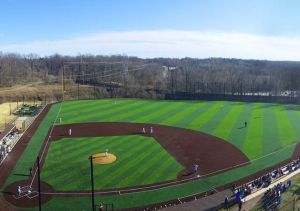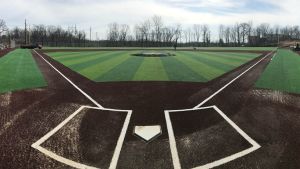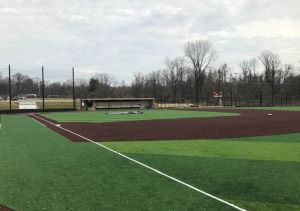
Artificial turf and real grass have recently been debated about for athletic fields. On one hand, natural grass and dirt feel pure and authentic whereas artificial turf is cheaper to maintain and isn’t affected by the weather as much as real grass. This was what led to turning the Cabrini-Carroll Field into an artificial turf.
Built back in March 2017, Cabrini-Carroll field was a collaboration between Archbishop Carroll High School and Cabrini to create a main facility for both their baseball teams to practice and play. It was also a necessary move considering that Cabrini’s topography and on-campus space made it impossible to build an entirely new field from scratch.
Cabrini head baseball coach Nick Weisheipl explained that the number of teams, combined with the difficult weather around the springtime was what led to Carroll field becoming an artificial turf.
“A natural field would have been a serious drain on time and financial resources attempting to keep it in adequate playing condition,” Weisheipl said.
Weisheipl also brought up that turf enhances play-ability for the team because all moisture drains from the surface after any form of wet weather. In addition, little maintenance is required to maintain the turf which saves a lot of time.
Typical maintenance of the turf includes regular surface grooming with a brush implement that ensures the infield remains consistent and making sure that the high-traffic areas by the batter boxes can be replaced.

While global warming wasn’t a factor in the decision to give the field artificial turf, Weisheipl said that environmental friendliness was taken into consideration in the decision.
“I know very strict stipulations are involved from an environmental stand point to make sure all consideration was given constructing an earth friendly venue,” Weisheipl said.
Cabrini outfielder Shaun Stackhouse, while a fan of natural grass over turf, loves the turf that Carroll field has.
“It is not as true as playing on grass and the feel of the traditional baseball game isn’t necessarily there,” Stackhouse said. “But it plays faster which allows us to get good work in when other teams can’t.”
Stackhouse has played on some turf fields in the past such as for tournaments and his high school football team. Despite having limited experience with it beforehand, he adapted to permanently playing on turf pretty well.
“I like it for the outfield because you don’t get choppy grass hops, everything hit at you is playable and clean,” Stackhouse said. “I also run a lot faster on turf than I do on grass, which is an integral part of my personal game style.”
According to Stackhouse, other advantages of playing on turf include the ability to play on grass which due to the lack of rough hops, and outfielders can take some velocity off their throws since the infielders can handle the hops on turf.
Starting right fielder Tyler Norris is also a huge fan of artificial turf because it allows him to be more aggressive when fielding and it’s adaptable to the weather as well.
“As an aggressive outfielder, there’s no better feeling than diving for a ball,” Norris said. I tend to do it a lot on turf simply because I rarely can get hurt since it’s such a smooth surface.”

Norris prefers artificial turf over grass because the ball runs faster and hops better which is easier for him in terms of both fielding and batting. In addition, Norris used to play on a grass and dirt field when he was at Drew University for his freshman year but wasn’t fond of it because the hops the ball took weren’t that good. Lastly, the field maintenance inconvenienced the team.
Norris also agrees with the fact that turf benefits the team because Cabrini’s baseball team is one of the only teams in the CSAC that has an artificial turf. As a result, they know how the ball works on the field and can adjust quickly compared to opposing teams.
Based on environmental conditions, financial costs and play-ability, the coach and the players agree that making Carroll field an artificial turf was the best choice for both Cabrini University and its baseball team.
“Our team plays very well on artificial turf because we are so used to it and no one else plays on turf, so we get the best of both worlds,” Norris said.



